In a country house, a pitched roof is most often arranged, however this is not always a simple job. Here you need to possess not only certain skills, but also knowledge about how the device of the roof truss system should be performed. Of course, there is also insulation, decoration and roofing, but the rafters are the foundation without which the rest of the elements do not make sense about the quality of the remaining elements.
Content
The order of the device of rafter structures
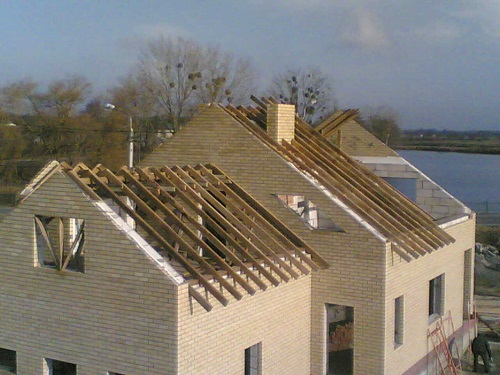
The main components in this case are the rafters themselves and the crate. The roof is just a layer of topcoat and materials that are necessary to ensure the appropriate microclimate in the attic. The type of truss structures depends on the type of roof. For single-pitched roofs, the simplest version is used, which involves the absence of any complex solutions, since to create such a structure on a building up to 5 meters wide, it is not enough just to lay the rafters, resting them on opposite walls.

In this situation, the term rafters means a beam or boards that will act as a "skeleton" of the roof and hold the weight of the roofing material and insulation. In other cases, the rafters can be composite and assemble from separate elements - rafter legs.
Before you choose one or another type of rafter system, you need to perform the appropriate calculation.
How to calculate rafter structures
The roof can last for a long time only if all the loads acting on it are taken into account. If there are several of them and the effect is separate, then they are all summed up. In the general case, it is necessary to add up the mass of the crate, the snow and wind loads, the weight of the roofing material, as well as the layers of insulation and waterproofing.
You can perform the calculation of the elements of the rafter system on your own if you understand this issue, or consult a specialist. The designer will do everything quickly, efficiently, but not for free. In favor of the second option, it should be noted that there is no need to pore over SNiP, studying various applications and changes in the standard, as well as mastering the modern software needed for calculations.
Another disadvantage of doing independent calculations is that in the event of any mistake, you can only blame yourself, and in the case of the roof, this can lead to a rather large consumption of building materials. Consider each of the types of load separately.
Calculation of snow load
One of the biggest dangers for the roof is the loss of a lot of snow, as this will lead to the creation of a real snowdrift if the slope of the slopes is not large enough. Weaknesses are valleys, dormers, etc. Under them, the rafter pitch is selected to be minimal in order to increase the strength of the structure in the case when the snow nevertheless begins to accumulate. For calculations, the weight of the snowdrift is calculated with a coefficient of 0.7. To compensate for the pressure of the snow mass in the valleys and near any structures protruding above the roof surface, a continuous crate is used, and the waterproofing layer is reinforced.
The second difficulty is that the snow bag will gradually move along the ramp and will reach the eaves overhang. If you make this element too large, then the expected effect will be damage to the cornice or its partial destruction.

In the case of a cornice, it is best to focus on those numbers that are recommended by the manufacturer of the roofing material.
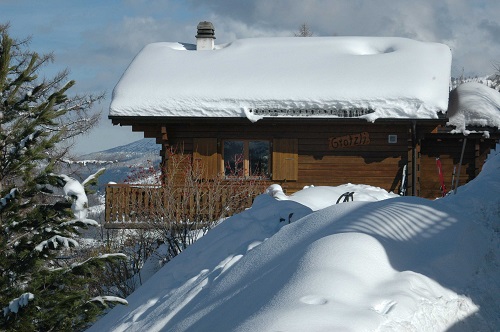
The snow load must be calculated taking into account the prevailing wind directions and the roof slope. A special factor is used here. For example, if the angle of the roof is 20 degrees, and the number of slopes is two, then m = 0.75 for the windward side and m = 1.25 for the leeward side. The table of values of this parameter is given in SNiP 2.01.07. If the angle of the roof is more than 60 degrees, then this coefficient is not required. Thus, to ensure the reliability of the roof structure, the rafter systems of which are created by hand, you need to take into account the full snow load. It is calculated by the formula Q1 = Q * m, where Q is the expected snow load and m is the tabular value. There is such a thing as normative snow load. It is calculated as follows: Q2 = 0.7 * Q1. If the snow is drifted by the wind, this also needs to be taken into account.

For windy areas, there is a correction introduced in the formula: C = 0.85. It acts when the wind speed exceeds 4 m / s when the slopes are inclined in the range from 12 to 20 degrees. It is worth saying that the correction is taken into account only when the average monthly temperature in winter is below -5 ° C.
Wind load calculation
In order to withstand the snow load, a sufficiently strong rafter system and a reliable crate, as well as a design that is created only after careful calculations, but with a wind load, the situation is somewhat different. The problem here is not to protect the roof from bursting, but in its reliable fixation. The wind would rather tear off the roof if the rafters were not secure enough.

The higher the roof and the greater the angles of its inclination, the stronger the wind load. However, one should distinguish between wind pressure and lift.
The wind exerts pressure at large angles of inclination of the structure, and at small angles of slopes there is a lifting force, which with a strong wind can turn your roof into a glider and carry it away. The wind load resistance coefficient is calculated using the following formula: Wp = C * W * k, where C is the aerodynamic coefficient used in calculating the forces acting on the windward and leeward slopes, W is the wind pressure, and k is the correction factor. The last two parameters can be obtained from special tables, which are given in SNiP. Parameter C is greater than or less than zero. It is positive in the case when the wind presses on the surface of the ramp, and negative - when the air flows smoothly at a small angle of inclination.
To counteract the forces developed by the wind, it is necessary to reliably fix the structural elements of the roof. For example, metal pins embedded in walls are used, to each of which a rafter leg is attached using a knitting wire.

If there are no strong winds in the area where the house is being built, then you can tie the rafter legs through one, since this method of fastening will protect the roof from accidental strong gusts.
Constant load calculation
The dead weight of the topcoat has no less effect than other factors. Moreover, the mass of heavy roofing acts on the rafters constantly. It is worth noting that the greater the weight of 1 m2 of material for the roof, the higher the angle of inclination of the roof is needed. Cement and ceramic tiles have the greatest weight, and various rolled materials are the smallest. Accordingly, the roof slope is selected for them, but there are exceptions to this rule.For example, metal and seam roofs, the slope of which can be 1: 5.
The choice of the design of the rafter system is made only after selecting the appropriate type of roof and performing all of the above calculations. In addition, it is necessary to take into account the type of coating, since with the increase in its specific gravity, the thickness of the rafter system increases. As a rule, a rafter plan is developed that takes into account all such nuances, as well as the thickness of the lathing.

Experts recommend first of all choosing the most attractive roofing materials in each case, since different types of lathing are used for different coatings, and it makes a considerable contribution to the constant load acting on the rafters.
In the calculation process, you must not forget about the insulation, the weight of which will also be considerable. In the case when it is planned to create an attic, one should also take into account the mass of material that will be required to perform the inner lining of the attic.
Movable rafter mounts
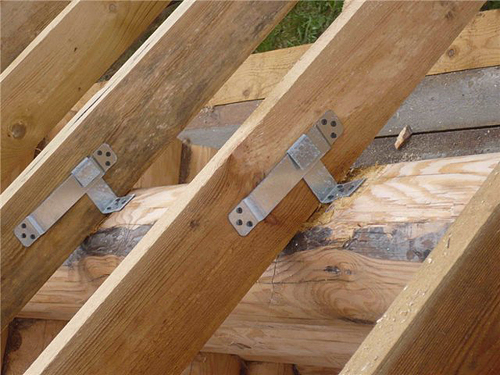
Wooden buildings are prone to shrinkage, so the roof for them should be mounted on special mounts. Resizing individual elements leads to stresses that can cause structural failure. To do this, the mounting point of the rafter leg and the Mauerlat or logs must be created so that the rafter can move perpendicular to the wall. Using a sliding support for rafters allows you to achieve the desired result. There are two types of mounts - open and closed. In the first case, a corner is used, one of the sides of which is bent and holds the second element. The L-shaped part of the mount is fixed to the guide, and the second element is connected to the Mauerlat.

If the Mauerlat has a rounded surface, then a platform is cut out on it, allowing you to position the mount. Installation is performed so that the movable element can move along the entire length of the guide.
When the slope of the roof is small, use only one mount on each rafter foot, and for large angles, the rafter beams in the place of contact with the Mauerlat are held by mounts on both sides.
An alternative to open mounting is a closed one, where the movable part is securely fixed. The main difference of such fasteners is that it is mounted in its entirety, while the open one can be mounted separately, and then assembled.
All such fasteners are made by stamping from stainless steel. The amount of free play depends on the manufacturer and ranges from 6 to 16 cm. The number of holes for mounting the guide also varies.
The influence of the shape of the roof on the type of rafter system
We already spoke above about how these or those features of a roof influence features of its internal structure, therefore we will give below various options of designs for gable and hip roofs. For gable options, the most simple, but nonetheless effective option, which provides sufficient roof reliability, is most often used. In this case, we are talking about a non-residential attic.
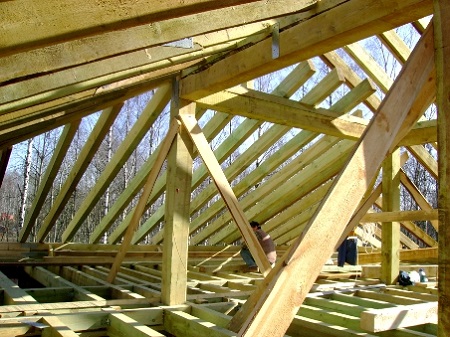
The roof structure is formed by two slopes and two pediments. Slopes are created by rafters resting on 3 points: a ridge, a rafter leg and a Mauerlat. The ridge run itself is made of timber and is supported by racks. The racks rest on the bench. In order to reduce the load transmitted to the walls, the rafters are made using puffs.
This element is made of timber, and its thickness depends on the height of the installation. The thinnest tightening can be located in the lower part of the structure, and with increasing height, the strength of this element must also be increased.

There are at least 4 main types of rafter systems for gable roofs, which we examined in the article “Roof construction: rafter systems and their construction”, so here we will not dwell on this issue.
Hip roofs are in no less demand today, so we note the main features of their device. Three types of rafters are used here:
- ordinary. These are the structural elements of the slopes, which are based on the ridge beam and Mauerlat;
- hip. Short rafters are based on diagonal elements. Their upper parts are connected to the parts of the rafter legs located in the corresponding position on the main slopes;
- diagonal. There are only four of them and they rely on the corners of the building with the lower parts, and the upper ones connect with the ridge beam. As an alternative, fastening to a board located on the extreme rafters of the main slopes is often used.
If you plan to build a new roof for the house or repair the old one, the information given here will help to carry out this work with a minimum of problems, and for more information about the nodes of the rafter system, you can study other articles presented on our website.

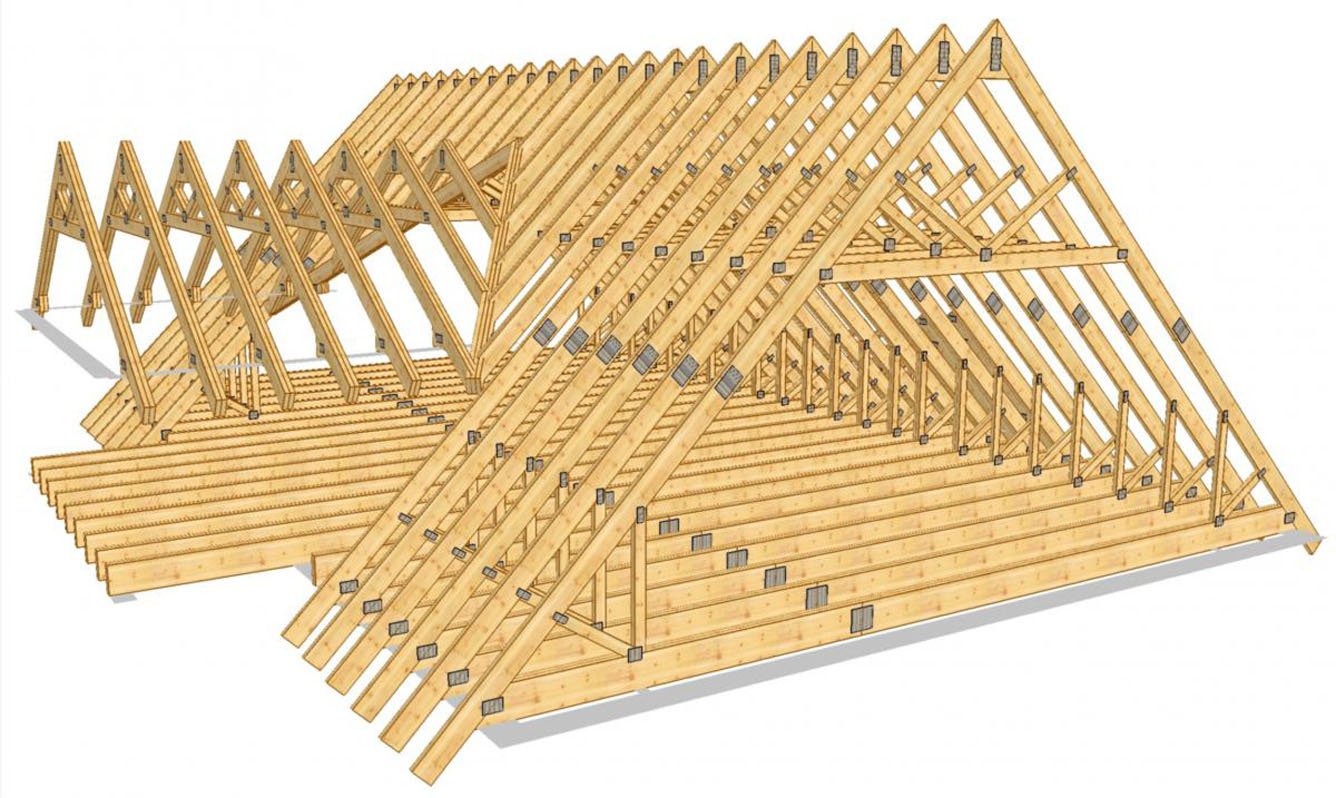



Alas, no comments yet. Be the first!